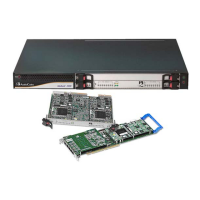SIP User's Manual 370 Document #: LTRT-68806
Mediant 2000 & TP-1610 & TP-260/UNI
8.4.2 PPPoE Overview
PPPoE is a method of sending the Point-to-Point Protocol over Ethernet network. PPPoE
provides the ability to connect a network of hosts over a simple bridging access device to a
remote Access Concentrator. Access control, billing and type of service can be done on a
per-user, rather than a per-site, basis.
A common use of the PPPoE is in the ADSL market: The home PC is connected to a
modem via Ethernet, and the PC uses the PPPoE to ‘simulate’ as if it was directly
connected to the remote host on a point-to-point connection.
Since PPPoE frames are sent over Ethernet, each PPP session must learn the Ethernet
address of the remote peer, as well as establish a unique session identifier. The PPPoE
standard describes a discovery protocol that provides this. A PPPoE session begins with a
discovery phase. Only after this discovery is completed can the PPP state machine start
(with LCP, Authentication etc, as described above).
Each of the Ethernet frames carrying PPP session has a standard Ethernet header
followed by PPPoE header, and is sent with the remote host Ethernet MAC address
(except for the very first one, in the discovery phase, which is broadcasted to all hosts).
Further information on the transmission of PPPoE is available on the IETF website
(http://www.ietf.org/rfc/rfc2516.txt
).
8.4.3 PPPoE in AudioCodes gateway
The AudioCodes gateway contains a PPPoE client embedded in its software. When
configured, the gateway can try to connect to a remote PPPoE Access Concentrator.
When resetting the gateway after several BootP attempts and if PPPoE is enabled (see ini
file parameter EnablePPPoE), the gateway tries to initiate a PPP session.
The gateway initiates a PPPoE discovery phase to discover a PPPoE Access
Concentrator. It does this by broadcasting a discovery initialization packet (PADI). If an
Access Concentrator exists and replies, the gateway tries to connect to this Access
Concentrator. If this initial connection succeeds, then the PPP LCP phase starts - each
side of the PPPoE connection sends an LCP configuration request to configure the PPP
link.The gateway PPPoE client supports both PAP and CHAP authentications. The type of
authentication protocol used is according to the request from the authentication server. In
the LCP configuration phase, the server requires a specific authentication (none, PAP or
CHAP are supported). The ini file parameters PPPoEUserName, PPPoEPassword, and
PPPoEServerName are used to configure the authentication parameters. If the Access
Concentrator is configured to operate in PAP, the PPPoEUserName and PPPoEPassword
are used as Username and Password (in this case, the PPPoEServerName parameter is
not used). If the Access Concentrator is configured to operate in CHAP, the
PPPoEUserName parameter functions as Client Name (sent in the CHAP response
packet), while the PPPoEPassword functions as the shared secret (calculated along with
the challenge to produce the response). In this case, the PPPoEServerName is the name
of the server (some hosts can be configured to authenticate to multiple servers. In such
hosts, the server name is used to identify which secret should be used).
Note: The AudioCodes gateway, being a PPPoE client, requests no authentication.
After the gateway has been authenticated, it needs to configure a network layer protocol.
The gateway uses the IP protocol. Therefore, the used NCP will be IPCP (IP Configuration
Protocol). In this phase, if the ini file parameter PPPoEStaticIPAddress is defined, the
gateway requests the remote host to assign this address for its use.

